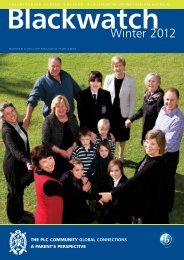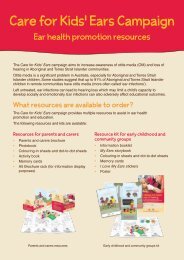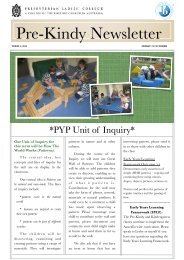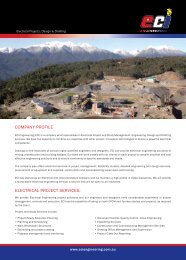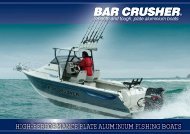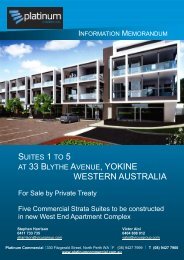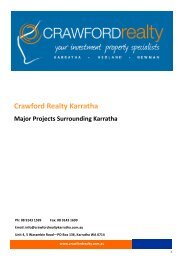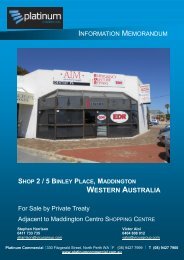Port Hedland Australia's iron ore boom town - Aussiehome
Port Hedland Australia's iron ore boom town - Aussiehome
Port Hedland Australia's iron ore boom town - Aussiehome
Create successful ePaper yourself
Turn your PDF publications into a flip-book with our unique Google optimized e-Paper software.
Hot spot | port hedland<br />
Map 2: Pilbara <strong>iron</strong> <strong>ore</strong> mines & deposits<br />
Source: FerrAus<br />
available at the centre.<br />
Upon its completion in August 2010,<br />
the centre will replace the existing<br />
<strong>Port</strong> <strong>Hedland</strong> health campus as the<br />
central healthcare hub for the Pilbara<br />
Gascoigne Health Region.<br />
4. Marina and Retail Precinct<br />
Development<br />
The largest initiative to improve the<br />
<strong>town</strong>’s amenities and appeal is the<br />
ambitious $69m Marina and Retail<br />
Precinct Development at Spoil Bank.<br />
This 258-recreational boat pen<br />
marina, mixed use commercial and<br />
residential project will create a complex<br />
comparable to the best marinas in Perth<br />
and Queensland.<br />
Situated at the eastern edge of<br />
the port’s entrance, the tourism-focused<br />
development will involve extensive<br />
dredging and a 300-metre protective<br />
breakwall. Both low and high<br />
density options for development are<br />
being considered.<br />
5. Road infrastructure upgrades<br />
The largest initiative underway is<br />
a $200m infrastructure project to<br />
upgrade and realign major roadways<br />
and build new bridges. This project<br />
is being jointly funded by the federal<br />
government ($160m) and state<br />
government ($60m) and will be<br />
vital to support the increased<br />
commercial, industrial and residential<br />
traffic as the <strong>town</strong> continues to<br />
rapidly expand.<br />
Other minor but significant projects<br />
include the following:<br />
• $9.6m increase in public amenities<br />
• $9m Finucane Island Community<br />
Function Centre<br />
• $9m <strong>Hedland</strong> Senior High<br />
School upgrade<br />
• $8.7m JD Hardie Youth Precinct<br />
• $8.2m Marquee Park community<br />
facilities<br />
• $6m in facilities and a new park for<br />
Cemetery Beach and Koombana<br />
• $5.3m Crime Prevention and Safety<br />
Initiative to increase security<br />
• $4.5m <strong>Port</strong> <strong>Hedland</strong> General<br />
Practitioner Housing Project to<br />
build nine new dwellings to attract<br />
GPs to the <strong>town</strong><br />
Pilbara powerhouse<br />
The Pilbara is Australia’s primary <strong>iron</strong><br />
<strong>ore</strong> region, with m<strong>ore</strong> than 20 operating<br />
mines (see Map 2). It is broadly split<br />
into two regions, according to the two<br />
railway networks owned by BHPB (East<br />
Pilbara) and Rio Tinto (West Pilbara).<br />
<strong>Port</strong> <strong>Hedland</strong> primarily services<br />
the East Pilbara <strong>iron</strong> <strong>ore</strong> mines along<br />
BHPB’s railway network and the<br />
relatively new FMG railway. However,<br />
there are a few smaller mines located on<br />
minor railway networks that the <strong>town</strong><br />
also supports.<br />
The West Pilbara Rio Tinto railway<br />
network is serviced by Australia’s<br />
other WA <strong>boom</strong> <strong>town</strong>, Karratha, and<br />
its two nearby ports of Dampier and<br />
Cape Lambert.<br />
Since the early 1960s when large<br />
quantities of <strong>iron</strong> <strong>ore</strong> were first<br />
discovered, the Pilbara region has been<br />
exporting <strong>iron</strong> <strong>ore</strong> to steel mills all<br />
around the world. Initially meeting<br />
the demands of a growing Japan, then<br />
South K<strong>ore</strong>a and now China, the region<br />
has helped create two of the largest<br />
companies in the world – BHP Billiton<br />
and Rio Tinto.<br />
Today, Australia supplies<br />
approximately 16% of the world’s <strong>iron</strong><br />
<strong>ore</strong> (according to the Australian Trade<br />
Commission), with the largest export<br />
markets being China (60%), Japan (25%)<br />
and South K<strong>ore</strong>a (10%).<br />
In 2009 the value of exports reached<br />
$29bn but are expected to soar to $47bn<br />
in 2010, according to the Australian<br />
Bureau of Agriculture and Resource<br />
Economics, as <strong>iron</strong> <strong>ore</strong> prices continue<br />
to rise on strengthening demand<br />
from China.<br />
The Pilbara region itself accounts<br />
for 89% of Australia’s <strong>iron</strong> <strong>ore</strong> deposits<br />
and, with 65 years of resources left at<br />
current production rates, has m<strong>ore</strong> than<br />
enough room to continue its rapid rate<br />
of mining expansion.<br />
Biggest port set to get larger<br />
<strong>Port</strong> <strong>Hedland</strong> is not only Australia’s<br />
largest exporting port but it is also the<br />
world’s largest bulk export port and<br />
biggest <strong>iron</strong> <strong>ore</strong> port. However, things<br />
are set to become even bigger.<br />
BHP Billiton has nearly completed<br />
its $2.1bn Rapid Group Project (RGP)<br />
4, which will increase its annual export<br />
tonnage by 26 megatonnes. At the<br />
same time construction has already<br />
commenced on RGP 5, a mammoth<br />
$6.1bn project to increase tonnage a<br />
further 50 megatonnes which will lift its<br />
total annual tonnage to 200 megatonnes<br />
– 100% m<strong>ore</strong> than 2007 levels.<br />
BHP Billiton is not alone in its<br />
expansion plans: Fortescue Metals<br />
Group, Hancock Prospecting and Atlas<br />
Iron all have ambitious expansion plans<br />
to increase <strong>iron</strong> <strong>ore</strong> exports.<br />
In total, <strong>iron</strong> <strong>ore</strong> exports from <strong>Port</strong><br />
<strong>Hedland</strong> are f<strong>ore</strong>cast to soar from 160<br />
megatonnes in 2009 to 460 megatonnes<br />
26<br />
www.yipmag.com.au





